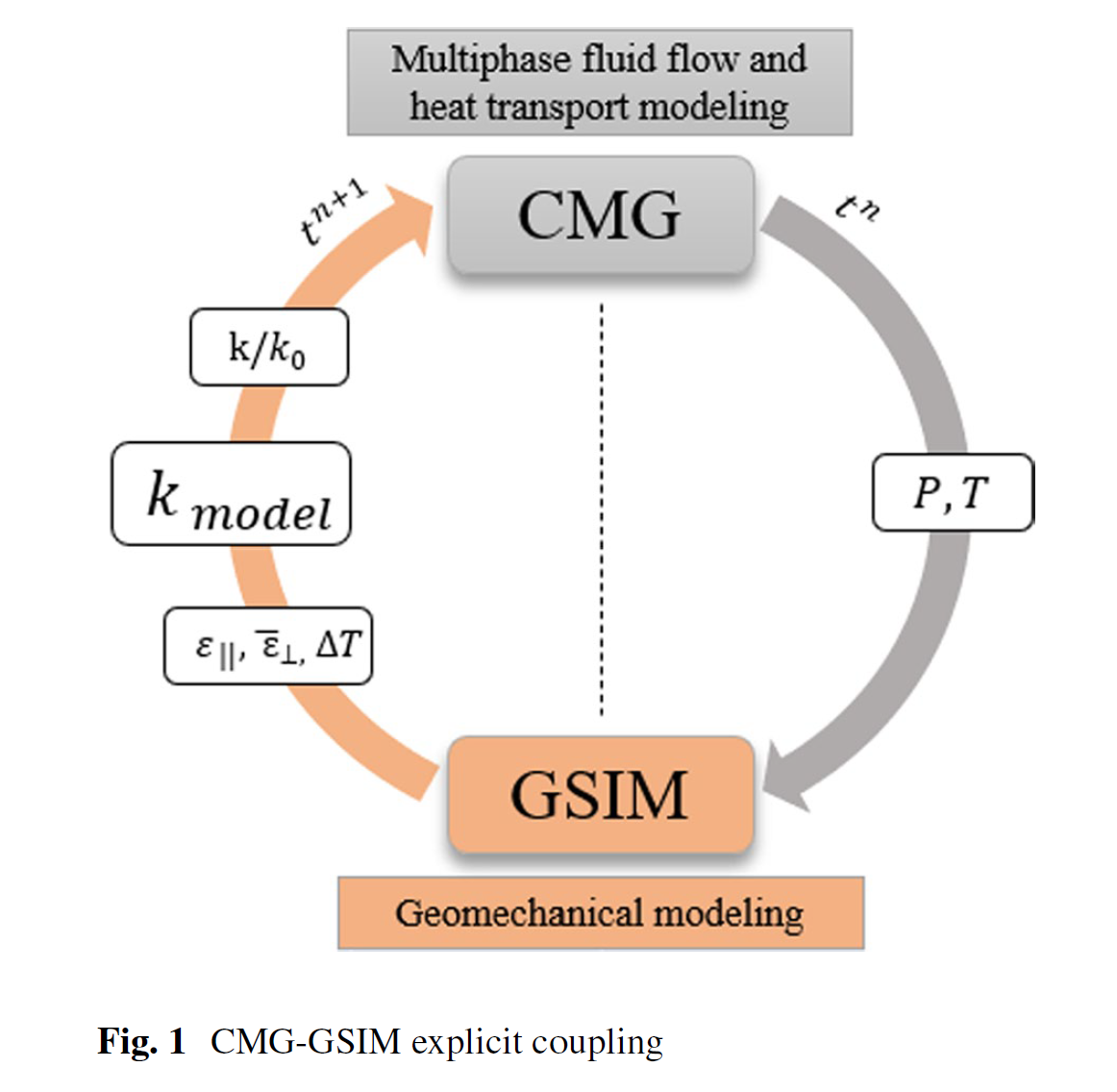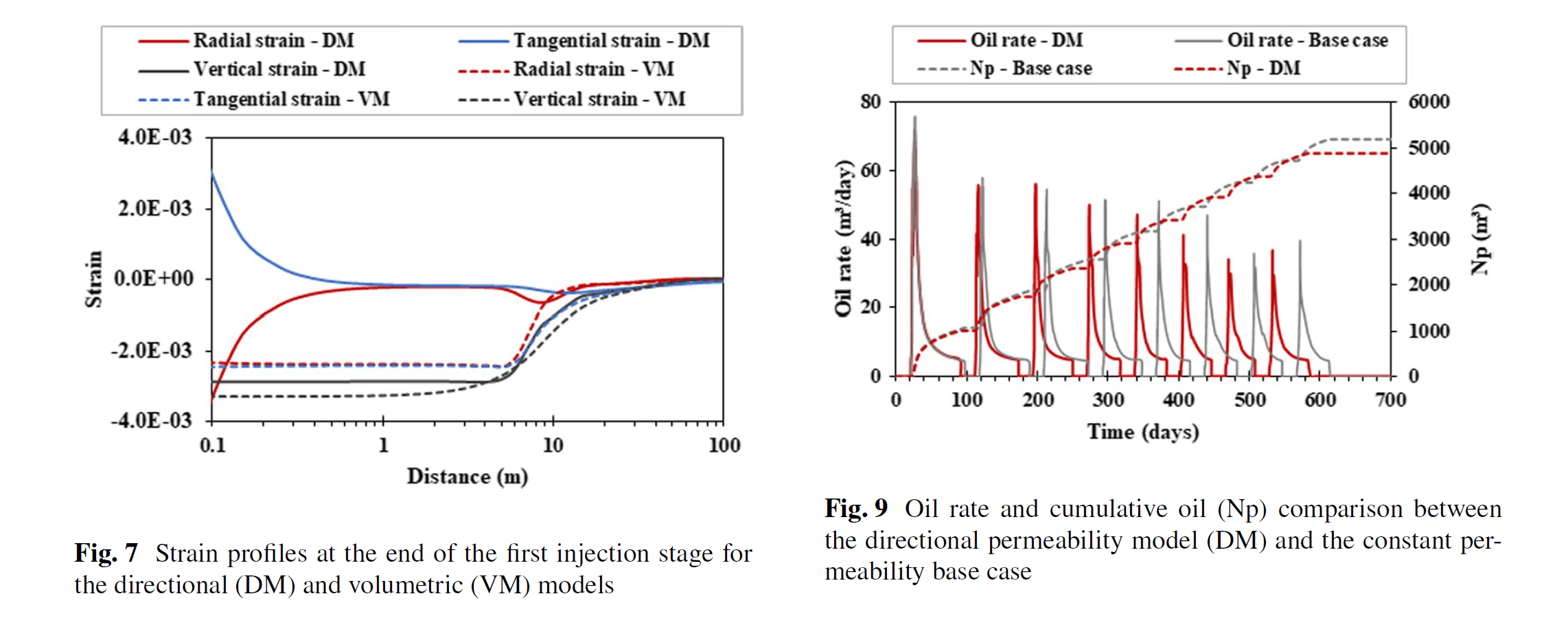Impact assessment of strain-dependent permeability on reservoir productivity in CSS
哥伦比亚国立大学
地质力学分析对于评估重质油藏蒸汽吞吐(CSS)作业的产量预测至关重要。在CSS过程中,高温高压流体注入以及多孔介质的松散和胶结不良可能导致储层渗透率在各个级别上发生可逆性变化与应力-应变响应相关。因此,必须考虑渗透率对岩石应变的相关性,以正确分析地质力学、压力和温度对储层性能的影响。本研究使用了一种提出的方向应变相关渗透率模型,通过数值模拟评估了产能,并与传统的体积渗透率模型进行了比较,考虑了井筒创建对应力-应变初始状态的影响。通过将CMG-STARS和地质力学内部模拟器GSIM进行显式耦合,使用所提出的模型进行模拟。油产量和渗透率剖面的结果显示,膨胀和压实阶段之间存在竞争关系,会改变多孔介质的结构。应力状态、应变和注入能量对渗透率参数有显著影响。本研究通过对CSS的可行性评估和优化,在产量预测中结合储层流动和地质力学行为分析中的近似值可能有所帮助。
Abstract
Geomechanical analysis is essential to assess the productivity forecast of cyclic steam simulation (CSS) operations in heavy oil reservoirs. The high-temperature and high-pressure fluid injection, as well as depletion in unconsolidated and poorly cemented porous media during CSS, may generate a relevant stress–strain response at levels that can lead to irreversible changes in reservoir permeability. Therefore, it is fundamental to consider permeability dependence on rock strain to properly analyze the impact of geomechanics, pressure, and temperature on reservoir performance. This paper implements a proposed directional strain-dependent permeability model to assess the productivity and compare it with a conventional volumetric permeability model through numerical simulation, considering the effects of wellbore creation on the stress–strain initial state. An explicit coupling between CMG-STARS and the geomechanics in-house simulator GSIM is carried out to perform the simulations using the proposed model. The results of oil production rates and permeability profiles show competitiveness between dilation and compaction periods that modify the structure of the porous media. There is a significant influence of stress state, strain, and injected energy on the permeability parameter. The approximations of this study might be used for feasibility assessment and optimization of CSS when integrating reservoir flow and geomechanical behavior analysis in productivity forecast.
Highlights
- Permeability changes near the wellbore are amplified when the open-hole internal condition is implemented in reservoir simulation.
- A flow capacity and productivity loss due to depletion are expected when CSS is implemented on unconsolidated heavy oil reservoirs.
- The permeability loss on reservoirs subjected to CSS may be managed by selecting the adequate operating variables.



6 Conclusions and recommendations
• The proposed directional strain-dependent permeability model assumes that each component in the strain tensor has its own effects on the changes in permeability in each direction due to the thermoporoelastic response of the porous media,
implying complex mechanisms between the permeability,rock elasticity and plasticity, grain size,shape, and sorting.
• A significant difference in near-wellbore permeability response is identified when comparing the volumetric and directional permeability approaches. The differences are attributed to the open-hole condition and the nature of the radial and tangential strains.
• To estimate the calibration parameters of the proposed directional strain permeability model, it is necessary to properly design a set of triaxial testing experiments with proper permeability measurements to calibrate and isolate strain and thermal effects when addressing permeability changes.
• Despite the overall permeability increase during injection stages, the production loss due to permeability variation is more evident in the later CSS cycles due to reservoir depletion and compressive strain accumulation. A certain competitiveness
is observed between dilation and compaction processes during CSS.
• Injection variables, such as injection rate and steam quality, report a greater effect on nearwellbore permeability. In contrast, production parameters such as the number of cycles and minimum oil rate impact the permeability value outward the thermal front. Hence, it may be possible to strategically modify operational parameters during the injection and production stages to mitigate and assess the risk of any permeability loss triggered by the thermal effects and reservoir depletion.
• For further research, it is suggested to assess the degree of irreversible permeability and strain variations to which the reservoir may be subjected in elastic/plastic regimes as a means to determine the potential permeability that can be restored through an adequate reservoir exploitation strategy. The anisotropic initial stress state should also be a sensitive scenario to analyze in thermal operations.
